Audubon County |
Home History Main 1915 History |
CHAPTER V.THE FIRST SETTLERS. (Cont'd)From History of Audubon Co., Iowa (1915)
| ||||||||||||
NATHANIEL HAMLIN.Perhaps others can tell the life of Mr. Hamlin better than the writer. He was a man of honor and integrity, truthful in an eminent degree, and generous to the limit--an old-fashioned gentleman. In mature life, he was of erect figure, five feet and ten inches in stature; weight, one hundred and fifty-five pounds; brown hair and eyes; light florid complexion, with thin, full beard. In later life he became stooped, and his hair and beard were gray. His book learning was limited and was received in the rude hut used for schools at that period, furnished with desks and seats split and hewed 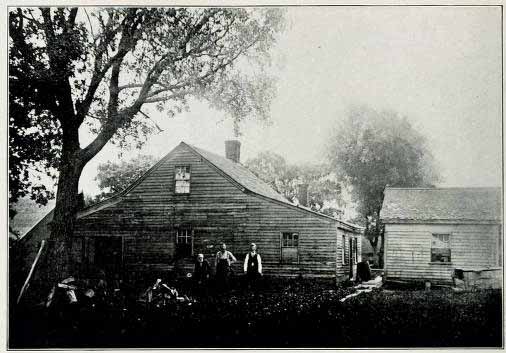 OLD HAMLIN HOUSE. WEST FRONT--Left to right: Hendrick R. Smith, 1856; Maturin L. Thomas, grandson of Nathaniel Hamlin; present owner, Isaac V. D. Lewis, 1854. The building at the right was the office of the Western Stage Co. up to 1868. 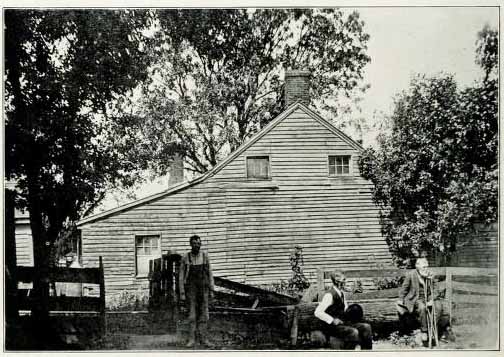 OLD HAMLIN HOUSE. EAST FRONT--Left to right: Maturin L. Thomas, grandson of Nathaniel Hamlin; Isaac V. D. Lewis, 1854; Hendrick R. Smith, 1856. from logs, and secured by big wooden pins. His training was physical, relating to the stern realities of pioneer life; hewing down the primeval forests and forcing a home from the wilderness, rather than the pursuits of literature. In youth he was an expert hunter, and, with gun and dogs, roamed through timber and mountains in pursuit of bear, deer and other wild game; and he was rewarded with trophies of his prowess in the chase. 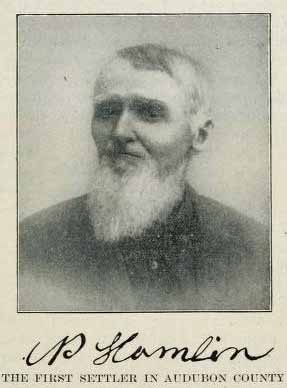 N. HAMLINTHE FIRST SETTLER IN AUDUBON COUNTYNathaniel Hamlin was born in Lewis county, Kentucky, March 13, 1814. On arriving at majority, he remained in his native place and worked at whip-sawing in the timber at one dollar and twenty-five cents a day. One season his crew got out the frame for a steamboat. He remembered the first saw-mill set up in that county. Before that event they lived in log cabins, floored with "puncheons," split out of logs and roughly hewed with broad-axes. After his father's death, in the fall of 1837, he left the "old Kentucky home" and went to Champaign county, Illinois, where he worked a season on the Illinois Central railroad. Two outfits worked on the job, one company being Americans, the other Irishmen. To his disgust he was put to work with the latter gang; but he soon discovered information which he turned to advantage. In addition to the regular wages paid, the laborers were allowed several "jiggers" (drinks of whisky) a day. Mr. Hamlin exchanged his share for labor with other workmen, and thus got to rest while others worked-in the absence of the "boss." On April 9, 1840, Mr. Hamlin married in Vermilion county, Illinois, Margaret, daughter of Allan and Margaret (Terrill) Poage. She was born in Greenup county, Kentucky, August 12, 1824. This proved the best adventure of Mr. Hamlin's life. For several years after marriage they had a struggle for existence. Times were hard, money scarce and farm products commanded but low prices. They were not landowners yet, but were obliged to accept indulgence for subsistence which was obtained. When the time for payment came they were less able to pay than at the start, so that a note for the debt, at twelve per cent, interest, was given for extension of time. This was paid at maturity out of the proceeds of hogs raised, fattened and marketed at one and a quarter cents a pound. About this time he got a job hauling grain to Chicago, which furnished the necessities for a living, and they secured a small lot of stock. They sold out in Illinois at extremely low prices (the best cow brought only seven dollars), and in the fall of 1844 went to Sand Ridge, near Trenton, in Henry county, Iowa. The following year he returned to Illinois to collect the proceeds of the sale of the previous year, and received pay in Indiana and Ohio bank notes, or "wildcat" money, which proved to be of doubtful value. This reverse brought them to the foot again financially. In the spring of 1845 they loaded their effects into two wagons and started for the new purchase made from the Sac and Fox Indians, where he had bought from his uncle, for thirty dollars on time, an abandoned claim of one hundred and twenty acres of land, in the extreme northwest corner of Mahaska county, on the Skunk river. Mr. Hamlin related: "When we got there I had but a five-franc piece left. Our claim had a log hut on it, without roof or floor, and we used the bark of basswood trees for a loft, the logs being split for rails. We lived there until the following September. Some people claimed that our 'wildcat' money was worth fifty cents on the dollar, but I gave eighty dollars of it on the Circleville, Ohio, bank for a squirrel rifle, which I still have and with which we procured all the meat we had for two years. During that time we lived on the scantiest fare, having neither coffee, except such as we made from parched corn, nor sugar, nor even soda for our bread. On a diet of cornbread and corn coffee, I have walked a mile and a half and split two hundred rails a day. After we had been in Mahaska county awhile, I went back to Henry county to mill, and while resting in an emigrant camp I found a half dollar, which was then more highly prized than one thousand dollars would be today. There was no money in the country until 1848, when a colony of Hollanders settled in Marion county. They soon built a grist-mill, which was a great relief to the settlers. I was now able to pay my claim. I might possibly have borrowed some money at very high rates, but when I got out of debt in Illinois I made a vow never again, if I could avoid it, to get into debt, and was determined to keep my word. At the end of two years my clothes were in tatters; but of two deer skins, which I tanned, I made, with whangs, a pair of pants and moccasins. With another buckskin I got my first start of hogs by trading it with a neighbor for a shoat, which I carried a mile and a half home on my back. A friend loaned us a cow, from which we obtained milk and butter." It was a common thing for Mr. Hamlin and his neighbors to grind corn for meal in a hand-mill. He was elected justice of the peace in 1846, and held the office until he came to Audubon county. In 1848 Mr. Hamlin made a trip to Illinois to visit friends. He agreed with a man to put up some hay for him while he was absent, which he failed to do. The corn was frosted, and some of it was cut up and shocked for feed. The snow came in October, before the ground froze, and laid all winter, so that in the spring they were able to gather their potatoes and turnips, which had laid in the ground all winter, unhurt. They suffered in Mahaska county from fever and ague, as they had in Illinois, and decided to move again and make another trial for a home. So they sold their land in Mahaska in 1850 for one thousand dollars, and took most of the pay in oxen and young cattle. We have previously given an account of the settlement of Mr. Hamlin and his family in Audubon county in 1851. The site of his home was on the south side of "Unexpected creek," a tributary of Troublesome, in the northeast quarter of section 35, now Exira township. This was on the Mormon trail, and there he made his home and lived the remainder of his life. It soon became the overland route to California, and later to Pike's Peak and the west, and brought traffic to his very door. "Hamlin's Grove" was known across the state of Iowa, from Davenport to Council Bluffs, as well as outside the state. A postoffice of the same name was established there and he was appointed the first postmaster in the county, receiving his commission under President Zachary Taylor in 1853, and held the office until removed by President Lincoln for political reasons, in 1861. The Western Stage company afterwards established a station at his place, of which he was agent, and continued until the advent of the railroad in 1869. He acquired a large amount of land and was extensively engaged in farming and stock raising. He employed many to work for him, and for many years was one of the most prosperous men in the county and one of the two most wealthy. His situation enabled him to dispose of his products to emigrants at good prices. In the early days he kept goods for sale. He, with Charles Marsh, started the first blacksmith shop in the county. He kept large numbers of horses and mules, which pastured over the prairies about Indian Grove and Crooked creek, in what is now Audubon township, and had many cattle and hogs. For several years at the close of the war, and later, he, with G. T. Poage and Levi Zaner, operated the steam saw and grist-mill, and did a thriving business at Old Louisville, the busiest place in the county, then and up to about the time of the advent of the Chicago, Rock Island & Pacific railroad to Atlantic. In 1855 he was elected first treasurer and recorder of the county, and held the office until 1864. For several years he was trustee of Audubon township, when it embraced the entire county. The following incident in his official career illustrates his offhand, characteristic honesty and fairness. In 1868 he was one of the judges of election. Audubon township was strongly Democratic, and the county was nearly divided in politics. The election board convened in the schoolhouse near Lewis's, and received votes until noon, when they adjourned for dinner at Mr. Hamlin's house. We suppose they had a good dinner there, as was usual, with the "trimmings" that went 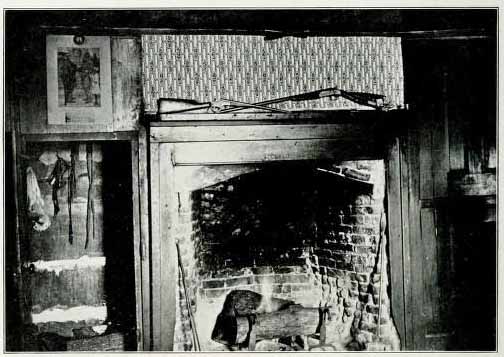 FIREPLACE IN OLD HAMLIN HOUSE. FIRST BRICK MADE IN AUDUBON COUNTY, 1858.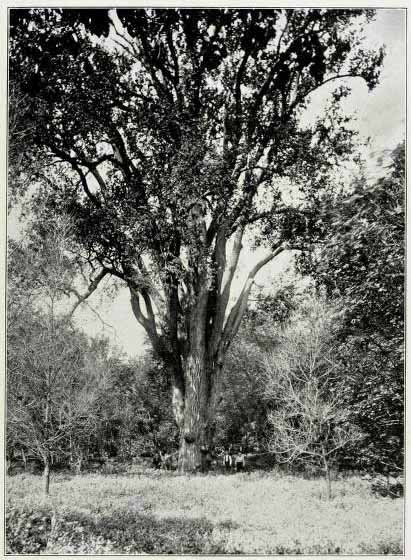 BIG TREE, 23 FEET IN CIRCUMFERENCE, ON OLD HAMLIN ESTATE.In 1854-5 Hamlin and his neighbors built a log building for a private school house, the first in the county, and hired a private teacher to teach his own children and those of Judge Harris. He was an influential man in the early days, and if a school house, highway, bridge or other public improvement was wanting, it was well to secure his assistance to insure success. In politics Hamlin was an old-fashioned, Andrew Jackson Democrat, for whom he cast his first presidential vote, and he supported Stephen A. Douglas for President in i860. A pro-slavery man, in his opinion it was a more heinous offense to steal a "nigger" than to steal a horse or any other kind of property. He strongly advocated opposition to the Civil War and the Republican administration, during that period; but he never committed any overt act of treason against the government. His sentiments were tinctured by the conduct of J. Lyman Frost toward himself. Mr. Hamlin was a high-spirited man, a leader in public affairs, and held prominent offices. Frost was a meddlesome, revengeful man, a dabbler in partizan politics in a small way. He and his party spied upon Mr. Hamlin and his party, and watched for an opportunity to injure and discredit him. It came by the removal of Hamlin from the postoffice for political reasons, and Frost was appointed in his place, which Mr. Hamlin keenly resented, rightly believing it was accomplished by Frost to injure him in public estimation. And it probably caused Hamlin to become a more bitter partizan. It is justice to Mr. Frost to add that he was a zealous Union man, and believed that he was doing his duty to the country. In other respects Hamlin was a good citizen, and was deeply interested in the progress and prosperity of the community in which he lived. A prominent citizen once remarked concerning him: "He was a good friend, but not a bad enemy." If he disliked a person he let him severely alone. Many a poor man in this county has received substantial aid and assistance from Mr. Hamlin, and his kindness of heart many times led him into obligations on behalf of his neighbors which left him many thousands of dollars out of pocket. He possessed a keen sense of honor and integrity. "His word was as good as his bond." No little of Mr. Hamlin's prosperity was attributable to his excellent wife. "Aunt Peggy" was admirably suited to pioneer life. The Hamlin home was the synonym for hospitality. The hungry never left their door unfed. No woman in Audubon county ever fed so many mouths, free gratis, as did this good lady. It seemed to make no difference how many dropped in at meal times, nor whether they came unannounced; she was equal to the occasion, and without excuses or ostentation, in a plain, common sense way, in surprising readiness, fed the multitude in a substantial manner. Their ordinary household was large, with their many children and hired help; then later, the employees of the stage company, who boarded and lodged there, and the passengers on the stages, and other travelers made uncertain numbers to feed and were numerous. People from all parts congregated there socially and on business, and the young people on Sundays made Hamlin's a public resort. A prominent citizen told the writer years ago that in early times here money was very scarce: that he was unable for months at a time to obtain enough specie to pay postage on letters to his friends. Mr. Hamlin was an exception to this condition. The money which came into this county generally found its way into his hands as postmaster or county treasurer. To facilitate the stringency of money, during war times, Mr. Hamlin issued script money, written on pasteboard. The artist who made it was our old-time friend, the late A. B. Houston, who ornamented the cards in his own particular method with pen and various colored inks. The following is a copy of a piece of the Hamlin script:
The following statement shows a difficulty with the money of those early days: "Fort Des Moines, October 25, 1854. "This is to certify that I paid Mr. N. Hamlin for J. Frink & Co. a ten-dollar bill on the State Bank of Ohio, which he cannot pass. It is said to be counterfeit. I took the bill for good money, but do not know who gave it to me."Edwin Taylor." ELECTION CERTIFICATE."This is to certify that at an election held in the town of Dayton, in said county and state, on the 3rd day of August, 1857, Nathaniel Hamhn, was elected treasurer and recorder for said county for the term of two years, he having given bond and taken the oath of office prescribed by law. "Given under my hand and seal of office, August 8, 1857. "D. M. Harris, County Judge." Like many old-fashioned people, Mr. Hamlin was partial to the favorite beverage of Kentucky, which he used in moderation all his life, and in early times kept it for sale. He usually had a generous supply in his house, which he was pleased to offer his friends and guests when under his hospitable roof.In 1870, before the resumption of specie payment, during an absence of Mr. Hamlin in Colorado on business, the writer, who was his attorney had occasion to look among his private business papers. He was shown into a secret place back of the chimney, and there, in a trunk, search was made for the necessary papers. In examining the contents of the trunk there were found two shot sacks, apparently filled with coins. Mentioning the fact to Mr. Hamlin years afterwards, he admitted that he had kept that specie on hand many years, all through the war period. He was one of those who did not have faith in the paper money of the United States, and believed that it would share the same fate as the old "wildcat" money. Mr. Hamlin was not a church member, but favored the Baptist faith. Mrs. Hamlin was a member of the Christian church. He died at his home, of paralysis on April 17, 1897. After his death Mrs. Hamlin moved to Exira, and died there on September 13, 1906. Most of the Hamlin estate has passed out of the hand of his descendants. A grandson, Maturin L. Thomas, owns the old homestead proper, on Troublesome creek. The children born to this worthy couple were as follow: Mary Margaret, who married Isaac Thomas; Hannah Maria, married Charles C. Hawk; Sarah Rosannah, married Benjamin F. Thomas; Malinda Christiana, married William Radcliff; William Allan, married Florence A. Lewis; Martha Jane, married Edward Calph; Eliza Angeline, died in 1859; Susan Parker, married John V. Plantz; Clara Harris, married John M. Allen; Nathaniel Douglas, married Elva Crane; Fernando Burton, married Emma E. Kilworth; Robert E. Lee, married Sadie J. Wheeler. | ||||||||||
